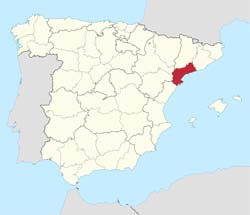Tarragona in Tarragona

Tarragona is the southernmost of Catalonia’s four provinces. To the north it borders on the Barcelona and Llérida provinces in Catalonia, to the east the Zaragoza and Teruel provinces in Aragón and to the south the province of Castellón in Valencia. To the east it borders on the Mediterranean Sea. The highest point in the province is the El Caro mountain in the Ports natural park. The mountain reaches a height of 1,441 MASL.
The province has two official languages, Castellano (Spanish) and Catalán, and all signs in the province are marked in both. Tarragona covers an area of 6,303 km2 and has a population of 804,664. This means a density of population of 127.6/km2, well above the national average of 94/km2. By far the largest concentrations of inhabitants are to be found in the coastal areas, with the interior becoming slowly depopulated, just like most of rural Spain. However, over the last decade the overall population numbers of Tarragona have been falling or, at best, stagnant.
 Tarragona’s long coastline, known as Costa Dorada (Golden Coast) is a popular tourist destination, both with foreigners and with Spanish, many of whom are not afraid to make a four-hour round trip to spend a day on the beach. In fact, the beach of Salou is known as ‘Playa de Zaragoza’ in spite of it being 239 km away from the city of Zaragoza.
Tarragona’s long coastline, known as Costa Dorada (Golden Coast) is a popular tourist destination, both with foreigners and with Spanish, many of whom are not afraid to make a four-hour round trip to spend a day on the beach. In fact, the beach of Salou is known as ‘Playa de Zaragoza’ in spite of it being 239 km away from the city of Zaragoza.
The capital of Tarragona is Tarragona, home to 136,496 souls in 2020. It is situated in the north of its province on the Mediterranean coast. During era of the Roman Empire, it was one of the most important cities on the Iberian Peninsula and it was the capital of two successive Roman provinces, Hispania Citerior and Hispania Tarroconensis. The city’s location on the Mediterranean Sea, more exactly on the popular Costa Dorada, with its long beaches and the warm sea, combined with its historic heritage has turned it into a first-class tourist destination.
The weather is another factor that turns the city into a popular destination; although the temperatures in summer sometimes reach as much 35ºC, this is normally for short intervals, with the temperature in the late 20s being much more frequent. The annual rainfall is very changeable, usually ranging between 300 and 700 mm a year – with the main rainy seasons being autumn and spring. It rarely snows in Tarragona, and when it does, the snow does not settle. Temperatures below 0 are virtually unheard of in the city.
The city was founded by the Romans and it still boasts many Roman remains, notably the aqueduct, ’Pont del Diable’ (The Devil’s Bridge) and the stunning amphitheatre, which faces the Mediterranean Sea. The latter was built between 1st and 2nd century AD and measured 130 x 102 metres. It housed up to 15,000 spectators. In conjunction with the Forum, parts of which can still be seen in the historic centre of the city, and the aqueduct, the amphitheatre has been nominated World Heritage Site by the Unesco.
After the fall of the Roman Empire, the history of Tarragona through the centuries has been marred by a succession of wars, the latest of which was, of course, the Spanish Civil War, which left the city badly scarred and in need of extensive reconstruction of both buildings and infrastructures, which labour went on well into the 1950s. Towards the end of that decade, some chemical industries started popping up in the area, and in 1975 a large oil refinery was inaugurated; this was the beginning of the conversion of Tarragona into an important centre of the chemical industry in Spain, and it led to an upturn in the city’s economy and population numbers.
Ever since then the port of Tarragona has remained in the top 5 largest and busiest ports in Spain. It is also home to Spain’s largest fishing fleet, although it has yet to be discovered by the cruise holiday companies. Today, Tarragona’s petrochemical industry is the largest and most important in Spain and more than 5,000 people are directly employed in the industry, while another 23,000 people work in related and indirect sectors. However, the most important sector in Tarragona is the tertiary sector, with tourism playing by far the largest part, although the city also boasts a wide range of jobs related to the university and other educational institutions


